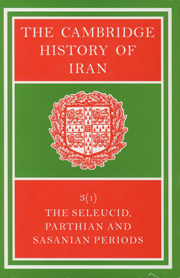Book contents
- Frontmatter
- Introduction
- PART 1 POLITICAL HISTORY
- 1 THE SELEUCID PERIOD
- 2 THE POLITICAL HISTORY OF IRAN UNDER THE ARSACIDS
- 3 IRANIANS IN ASIA MINOR
- 4 THE POLITICAL HISTORY OF IRAN UNDER THE SASANIANS
- 5 THE HISTORY OF EASTERN IRAN
- 6 THE POLITICAL HISTORY OF TRANSOXIANA
- 7 THE IRANIAN SETTLEMENTS TO THE EAST OF THE PAMIRS
- PART 2 NUMISMATICS
- PART 3 IRANIAN HISTORICAL TRADITION
- PART 4 IRAN AND HER NEIGHBOURS
- Bibliography
- Plate section
- Plate section
- Plate section
- Map 3. The western regions of the Sasanian empire">
- Map 11. The Silk Road from China to the Roman Orient
- References
5 - THE HISTORY OF EASTERN IRAN
from PART 1 - POLITICAL HISTORY
Published online by Cambridge University Press: 28 March 2008
- Frontmatter
- Introduction
- PART 1 POLITICAL HISTORY
- 1 THE SELEUCID PERIOD
- 2 THE POLITICAL HISTORY OF IRAN UNDER THE ARSACIDS
- 3 IRANIANS IN ASIA MINOR
- 4 THE POLITICAL HISTORY OF IRAN UNDER THE SASANIANS
- 5 THE HISTORY OF EASTERN IRAN
- 6 THE POLITICAL HISTORY OF TRANSOXIANA
- 7 THE IRANIAN SETTLEMENTS TO THE EAST OF THE PAMIRS
- PART 2 NUMISMATICS
- PART 3 IRANIAN HISTORICAL TRADITION
- PART 4 IRAN AND HER NEIGHBOURS
- Bibliography
- Plate section
- Plate section
- Plate section
- Map 3. The western regions of the Sasanian empire">
- Map 11. The Silk Road from China to the Roman Orient
- References
Summary
Even during the heyday of the Achaemenian empire an active part was played in its history by the peoples of eastern Iranian stock and language. As early as the battle of Marathon (490 B.C.) the Sakas - Iranian nomads of Central Asia - had fought side by side with the élite troops of the Persian centre. On board the Persian fleet at Salamis in 480 B.C. the marines, a corps no doubt specially selected for their reliability, included Sakas as well as Medes and Persians. In addition the land army which Xerxes led to Greece in the same year contained many eastern Iranian contingents. The “Amyrgian” Sakas of Herodotus (who are called the Saka Haumavarga in the Old Persian inscriptions, and who, in the hieroglyphic inscriptions of Darius I from the Suez Canal are defined as the “Sakas of the plains”, as opposed to the “Sakas of the marshes”) were then brigaded with the Bactrians under the command of Hystaspes, a son of Darius. Also present were the people of Aria (Herāt), led by Sisamnes; Parthians and Chorasmians led by Artabazus; Sogdians under Azanes, and Sarangians (Drangians), from the country of the lower Helmand, under Pherendates. The Chorasmian, Dargman b. Harshin, named in an Aramaic papyrus of 464 B.C. from Elephantine in Egypt, and engaged in litigation over land with one of the Jewish inhabitants, could thus have been a pensioned survivor from Xerxes' Grand Army. In this way, the principal eastern Iranian nations, both nomadic and sedentary, make their first appearance in the pages of history.
Keywords
- Type
- Chapter
- Information
- The Cambridge History of Iran , pp. 181 - 231Publisher: Cambridge University PressPrint publication year: 1983
References
- 7
- Cited by



